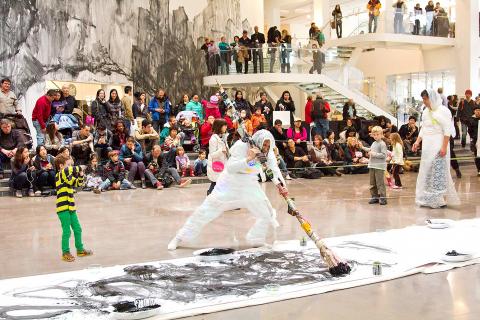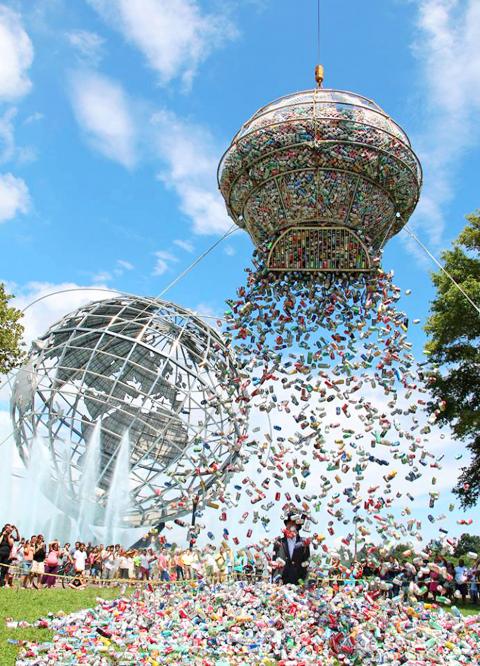As if it weren’t enough to have 30,000 aluminum cans dropped on his head, Yang Chin-chih (楊金池) performed the feat twice — first in 2012 in New York and two years ago in Taipei.
“The New York performance wasn’t so bad, but it was raining in Taipei and the cans were full of water,” the New York-based multidisciplinary performance artist says. “They also dropped [too many] at once. I could barely stand, my head was in constant pain.”
Entitled Kill me or Change, the piece was part of Yang’s efforts to highlight environmental issues, as he estimates that the average person would use and discard about 30,000 cans in his or her lifetime.

Photo courtesy of Yang Chin-chih
The performance is featured in filmmaker Huang Ming-chuan’s (黃明川) full-length documentary about Yang’s work and life, Face the Earth (肉身搏天), which will make its Taiwan premiere on Saturday at the Chiayi International Art Doc Film Festival (嘉義國際藝術紀錄影展), which runs until April 1. Yang will be available for a post-screening discussion.
The film is not completely new to Taiwanese cinephiles, as a short version made it into the top 10 in the 2014 New Taipei City Documentary Film Awards (新北市紀錄片獎). Yang says while he focuses on both environmental issues and social issues caused by new technology, Huang’s film focuses on the former as well as Yang’s multiple surgeries to fix the left side of his face, which was paralyzed after he suffered a mini-stroke during his compulsory military service.
“I wasn’t sure about being in a documentary, but Huang told me that his films are often used for educational purposes. So is my art — I want more people to know that we should protect our environment,” he says.

Photo courtesy of Yang Chin-chih
Yang moved to New York in the early 1980s to study at Parsons School of Design. After graduation, he worked a number of jobs to support his art, including a stint at Benihana restaurant, where the chefs perform culinary acrobatics and tell jokes to entertain diners.
“That was my first public performance,” Yang laughs.
He remained in New York, but his name made it back to Taiwan in 2007 when he was questioned by the FBI for driving around New York, projecting the Taiwan flag and other independence-related symbols on the UN building and other locations such as China’s US consulate.
Yang became interested in environmental issues when he visited a paper recycling plant about 20 years ago. He noticed how many chemicals were used in the process and how recycled paper is more expensive than regular paper.
“I realized that recycling is not enough,” he says. “I think our financial system and economic structure must change. We need to stop mass producing and create quality products that last longer.”
As an example of his explorations of how technology affects humans, in Invisible Love and Beauty Yang took an ancient communication tool — a giant calligraphy brush made of natural material — and adorned it with wires, cell phones and other modern devices. He then asked people to call the phones so they would ring while he painted.
Yang says his art usually contains many components, and Kill Me or Change is more than a single act of dropping cans. For example, he enlisted more than 100 people to help him collect the cans over several years. Many were purchased from homeless can collectors around New York City, and he also asked children he taught at public school art classes bring him cans.
Through this interaction, Yang’s message of environmental protection reaches a larger audience than is present at the performance.
“My art used to be very traditional,” he says. “But I feel the need to keep up with changes in society. The change I can effect in society is limited as an artist, so I have to make my art more interactive and work with more and more people.”

“Why does Taiwan identity decline?”a group of researchers lead by University of Nevada political scientist Austin Wang (王宏恩) asked in a recent paper. After all, it is not difficult to explain the rise in Taiwanese identity after the early 1990s. But no model predicted its decline during the 2016-2018 period, they say. After testing various alternative explanations, Wang et al argue that the fall-off in Taiwanese identity during that period is related to voter hedging based on the performance of the Democratic Progressive Party (DPP). Since the DPP is perceived as the guardian of Taiwan identity, when it performs well,

The Taiwan People’s Party (TPP) on May 18 held a rally in Taichung to mark the anniversary of President William Lai’s (賴清德) inauguration on May 20. The title of the rally could be loosely translated to “May 18 recall fraudulent goods” (518退貨ㄌㄨㄚˋ!). Unlike in English, where the terms are the same, “recall” (退貨) in this context refers to product recalls due to damaged, defective or fraudulent merchandise, not the political recalls (罷免) currently dominating the headlines. I attended the rally to determine if the impression was correct that the TPP under party Chairman Huang Kuo-Chang (黃國昌) had little of a

At Computex 2025, Nvidia CEO Jensen Huang (黃仁勳) urged the government to subsidize AI. “All schools in Taiwan must integrate AI into their curricula,” he declared. A few months earlier, he said, “If I were a student today, I’d immediately start using tools like ChatGPT, Gemini Pro and Grok to learn, write and accelerate my thinking.” Huang sees the AI-bullet train leaving the station. And as one of its drivers, he’s worried about youth not getting on board — bad for their careers, and bad for his workforce. As a semiconductor supply-chain powerhouse and AI hub wannabe, Taiwan is seeing

Jade Mountain (玉山) — Taiwan’s highest peak — is the ultimate goal for those attempting a through-hike of the Mountains to Sea National Greenway (山海圳國家綠道), and that’s precisely where we’re headed in this final installment of a quartet of articles covering the Greenway. Picking up the trail at the Tsou tribal villages of Dabang and Tefuye, it’s worth stocking up on provisions before setting off, since — aside from the scant offerings available on the mountain’s Dongpu Lodge (東埔山莊) and Paiyun Lodge’s (排雲山莊) meal service — there’s nowhere to get food from here on out. TEFUYE HISTORIC TRAIL The journey recommences with